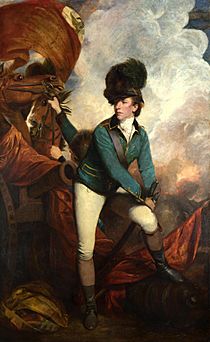British Legion (American Revolution) facts for kids
The British Legion was a special army unit created during the American Revolutionary War. It was made up of American colonists who stayed loyal to Britain (called Loyalists). These soldiers included both foot soldiers (infantry) and horse soldiers (dragoons).
This unit was also known by nicknames like Tarleton's Raiders, the Green Devils, the Green Horse, and the Green Dragoons. These names came from their leader, Lieutenant Colonel Banastre Tarleton, and the green uniforms worn by his officers. The British Legion was like a small, independent army. It had infantry, cavalry, and even cannons (artillery), allowing it to operate on its own.
Forming the Legion
This special unit was put together in New York in July 1778. General Sir Henry Clinton wanted to combine several smaller Loyalist groups into one strong force. This new "legion" would have both foot soldiers and horse soldiers, plus light, fast-moving cannons.
The infantry part of the Legion included groups like the Caledonian Volunteers and the Royal American Reformers. The cavalry (horse soldiers) came from units such as the New York Dragoons and the Philadelphia Light Dragoons.
The first commander of the Legion was William, Lord Cathcart. However, once the unit left New York, Lieutenant Colonel Banastre Tarleton took charge of its daily operations. At its strongest, the Legion had about 250 horse soldiers and 200 foot soldiers.
Fighting in the Carolinas
Parts of the British Legion fought in the Siege of Savannah in 1779. A siege is when an army surrounds a place to try and capture it. The whole Legion was part of the British force that surrounded and captured Charleston in 1780.
The Legion took part in many battles during the British campaign in South Carolina. They defeated American forces at Monck's Corner and Lenud's Ferry. They also had a difficult fight against American forces at Waxhaws.
During 1780, the Legion received more soldiers, including some from the Prince of Wales' American Volunteers. After Lord Cornwallis became the leader of the British forces in the South, the Legion helped him defeat General Horatio Gates at the Battle of Camden.
They nearly captured Thomas Sumter at Fishing Creek. The Legion was also surprised by an attack at Wahab's Plantation and held back by American rebels at Charlotte until more British troops arrived.
Throughout the fall of 1780, the British Legion worked to stop rebel fighters (guerrillas). They tried to hunt down leaders like Francis Marion and Thomas Sumter. They also fought at Fishdam Ford and Blackstock's. The Legion sometimes destroyed property to try and stop people from supporting the rebels.
In January 1781, the Legion was part of the force led by Tarleton that was defeated by Daniel Morgan at the Battle of Cowpens. The Legion lost many soldiers in this battle, especially its infantry. After Cowpens, the remaining foot soldiers either joined the cavalry or went to protect Charleston. From then on, the British Legion mainly operated as a cavalry (horse soldier) unit.
After getting new soldiers, the Legion led Cornwallis's army into North Carolina. They were looking for the American army led by Nathanael Greene. They saw action at Cowan's Ford and Tarrant's Tavern.
On March 7, 1781, the Legion officially became part of the regular British Army. This meant they were no longer just local troops. On March 15, the regiment fought at the Battle of Guilford Court House.
Campaign in Virginia
As Lord Cornwallis moved his army to Virginia, the British Legion cavalry, led by Tarleton, rode ahead. They almost captured Virginia Governor Thomas Jefferson and the state's government in Charlottesville. The Legion again caused widespread damage to punish rebel supporters and prevent them from helping the American army. In July 1781, a fight known as Francisco's Fight happened between Peter Francisco and some of Tarleton's Raiders.
When Cornwallis's army settled at Yorktown, the Legion was stationed across the York River at Gloucester. They later fought a small battle with French troops there. The Legion surrendered to the French when the siege of Yorktown ended.
Lord Cornwallis tried to get terms of surrender that would protect the Loyalists in his army. However, George Washington refused. Some of the Legion's men were sent to New York after the surrender. Some officers were released on parole (a promise not to fight again). Other enlisted men and a few officers were sent to a prison camp in Pennsylvania.
Disbanding the Legion
On December 25, 1782, the regiment was officially made part of the British Army. This suggests there might have been a plan to keep them after the war. However, the British Legion was officially disbanded on October 10, 1783.
The Legion's infantry who were still in Charleston, and those who had escaped to New York, were eventually moved to Nova Scotia in Canada in 1783. Some officers joined other British Army regiments. Most of the soldiers who were discharged settled in Nova Scotia.


